Warning: pic heavy as usual. 
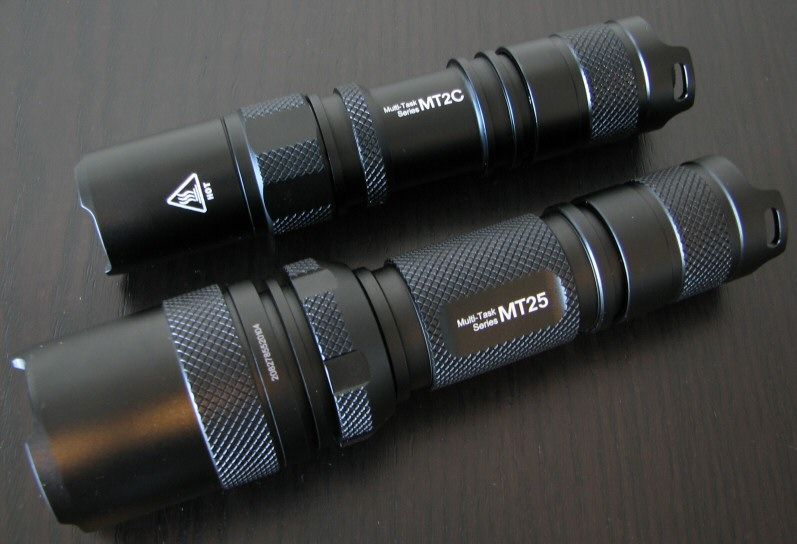
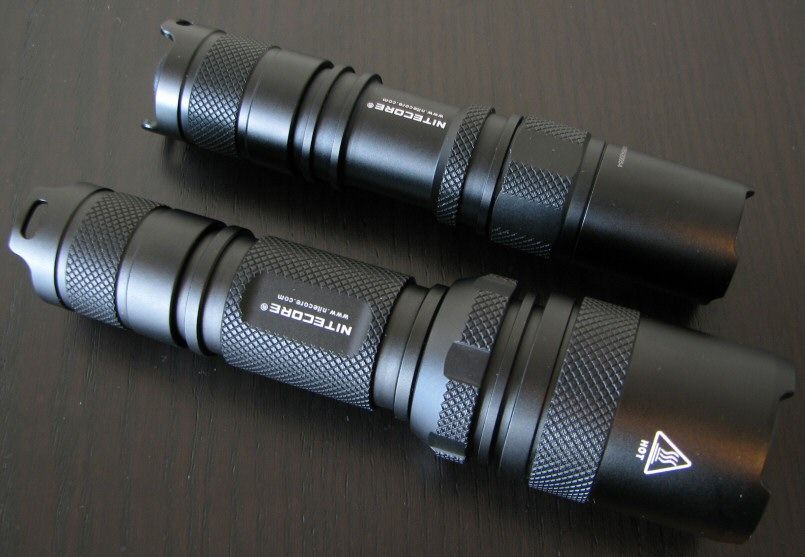
This is my third (and final) review of the "Multi-Task" MT-series lights from Nitecore. In this review, I am comparing the performance of two of the 2xCR123A/RCR, 1x18650 models – the MT2C and MT25. Please see my recent MT1C/MT1A/MT2A and M40 reviews for more details on those models.
Manufacturer Reported Specifications:
Note: as always, these are only what the manufacturer reports. To see my actual testing results, scroll down the review.
Common Specs:


All the MT-series lights come in basic display packaging, similar to the recent Nitecore Explorer and SENS series (MT1A shown above as an example). Extras are generally comparable, and include a basic wrist lanyard, extra o-rings and boot cover, removable pocket clip, manual and warranty card. The MT25 also comes with a basic holster with velcroed closing flap (not shown).
Here's a quick overview of the family:
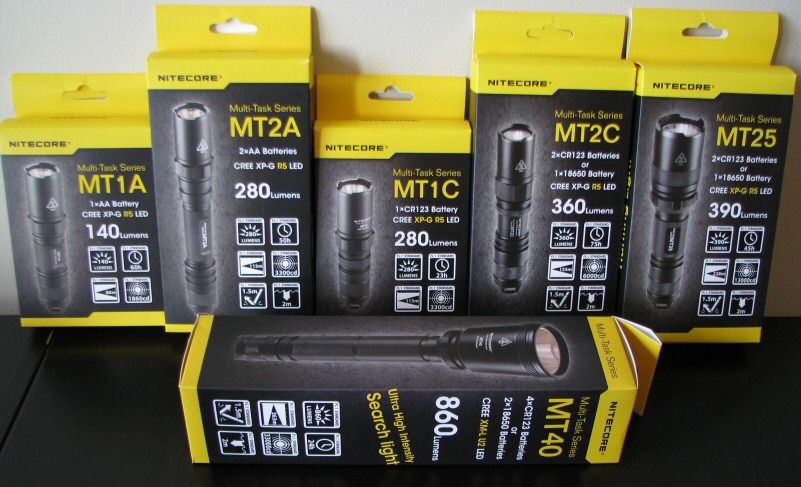
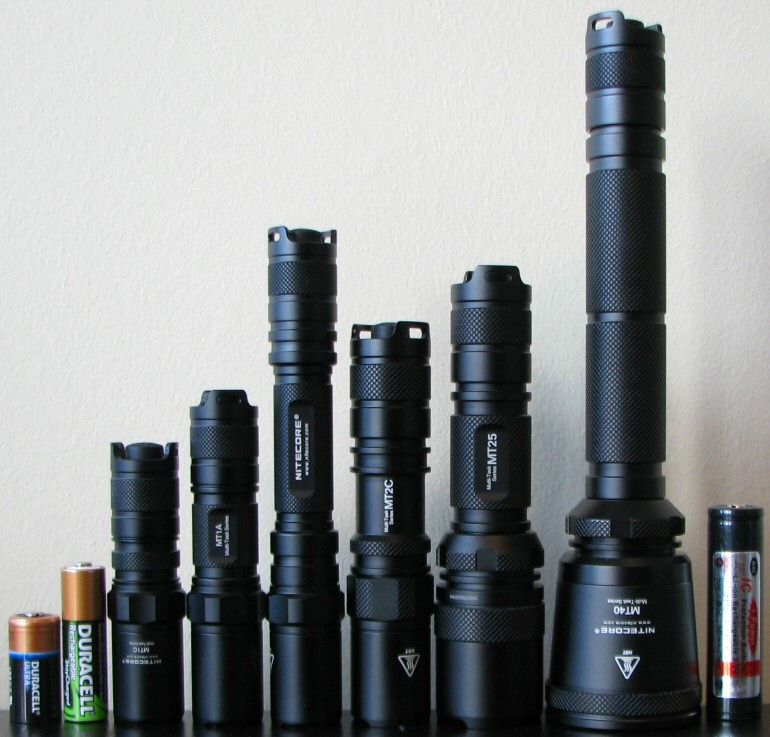
From left to right: Duracell CR123A, AA (NiMH); Nitecore MT1C, MT1A, MT2A, MT2C, MT25, M40, AW Protected 18650 (2200mAh).
And now a comparison on the MT2C and MT25:
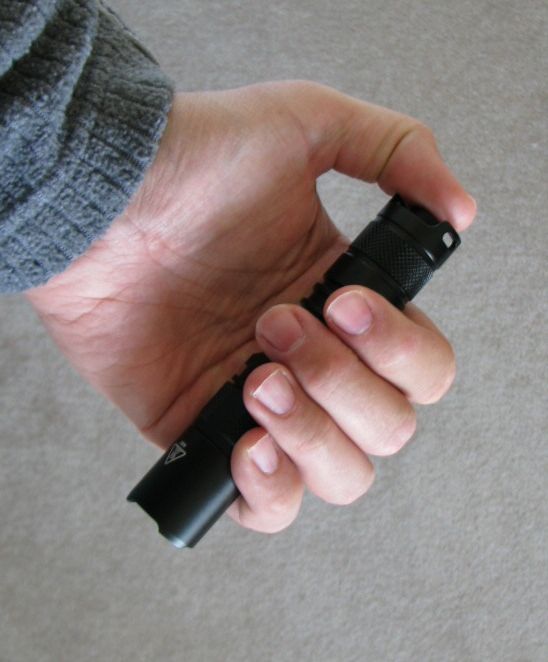

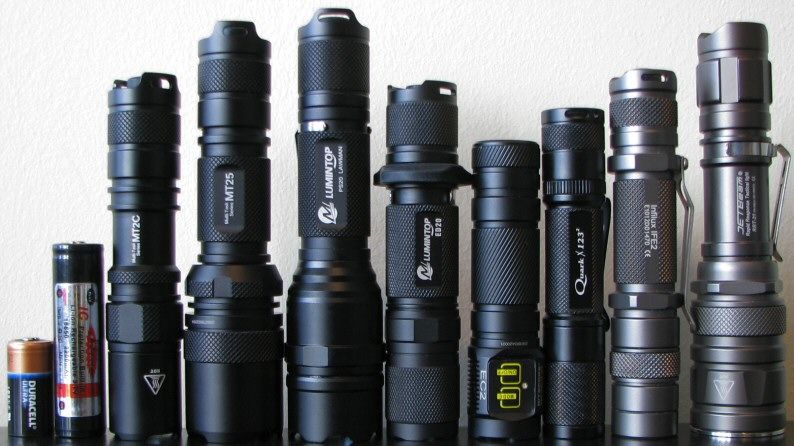
From left to right: CR123A; AW Protected 18650; Nitecore MT2C, MT25; Lumintop PS20, ED20; Nitecore EC2; Quark Q123-2; Nitecore IFE2; Jetbeam RRT-21.
All dimensions are given with no batteries installed:
Nitecore MT2C: Weight: 75.9g, Length: 125.3mm, Width (bezel): 25.5mm
Nitecore MT25: Weight 124.6g, Length: 142.9mm, Width (bezel): 34.2mm
Eagletac D25LC2: Weight: 50.0g, Length: 116.3mm, Width (bezel): 22.5mm
Foursevens Quark Q123-2-X (Regular tailcap): Weight: 44.6g, Length: 112.7mm, Width (bezel) 22.0mm
Klarus XT11: Weight 133.0g, Length: 148.8, Width (bezel) 35.0mm
Sunwayman V20C: Weight: 117.4g, Length 133.0mm, Width (bezel) 32.2mm
Thrunite TN10: Weight: 154.7g, Length: 145.5mm, Width (bezel): 35.1mm
Zebralight SC600: Weight 87.2g, Length: 107.8mm, Width (bezel) 29.7mm
MT1C:
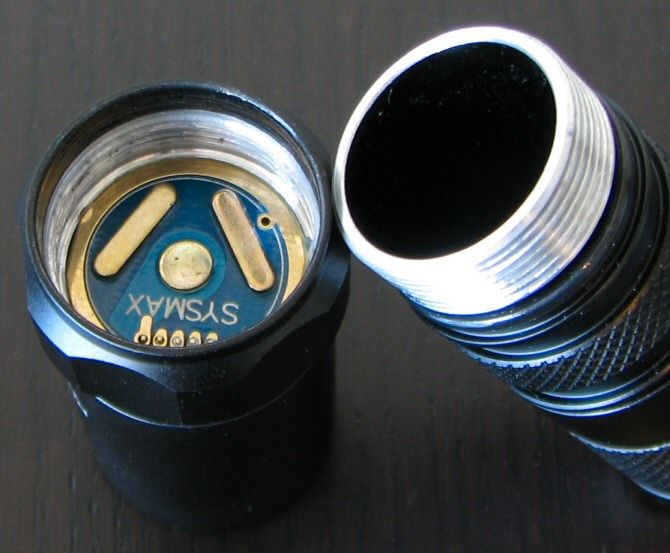
MT25:
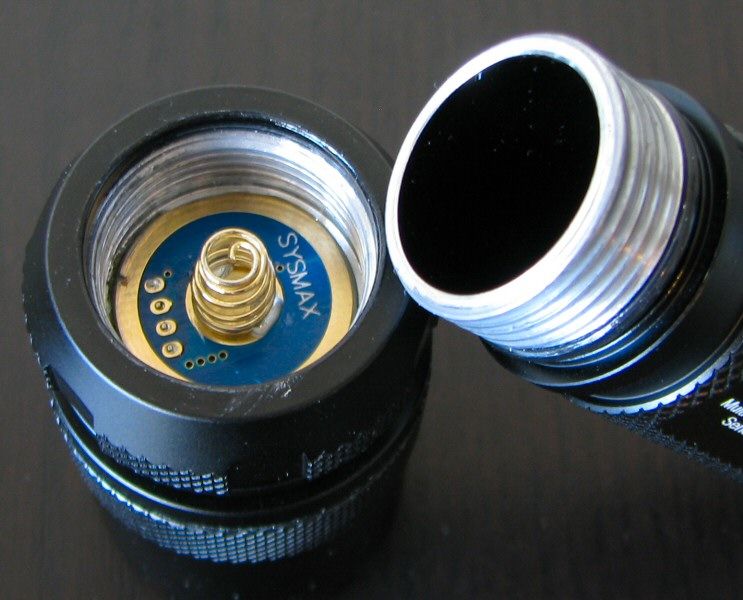
MT1C:
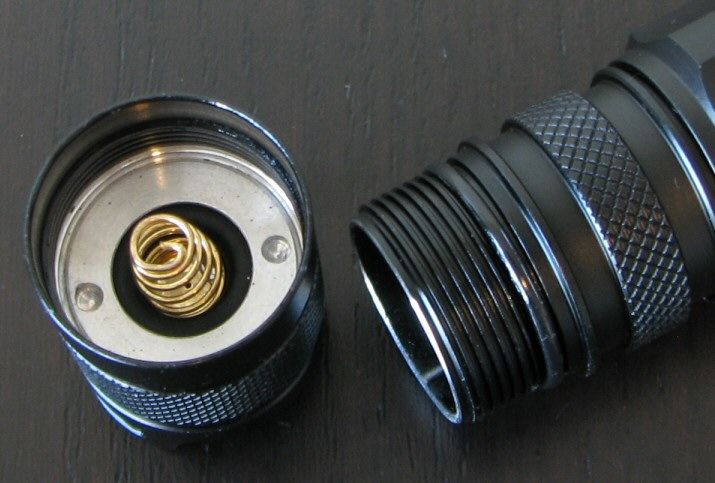
MT2C/MT25:
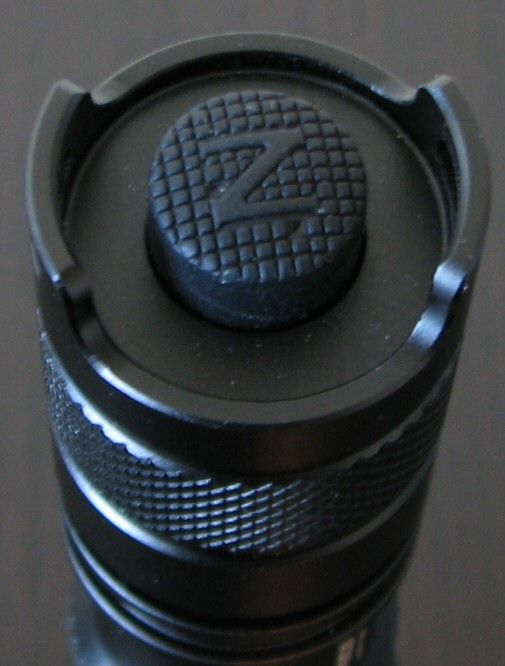
Anodizing is a matte black, with no chips on my samples. Labels are bright white, clearly legible against the dark background. Both models have actual knurling across the tailcap and portions of the battery tube and head (the MT25 has considerably more than the MT2C). Knurling is actually of reasonable aggressiveness, and grip is improved compared to the Jetbeam Backup-series lights which these new Nitecores most closely resemble (i.e., BC- and BA-series lights).
On the MT2C, there is a reverse-polarity setup in the head, so flat-top cells will not work in these lights (i.e., need a small button top, the same as the MT1C/MT1A/MT2A). The MT25, however, has a spring on the contact board in the head, so flat top cells can be used. Both lights have body tubes wide enough to take high-capacity protected 18650 cells. :thumbsup:
Both lights come with the same removable pocket clip, which is of the standard clip-on variety (i.e., similar to the Jetbeam Performance and Backup series lights).
Screw threads are standard triangular cut, and seem of good quality. They are also anodized for lock-out at the tailcap. Tailcaps size and threading are identical across the two models (i.e., are interchangeable). Tail switch is a forward clicky, with traditional feel. The Jetbeam Backup and Performance series lights often felt a bit "squishy" in comparison.
Light can tailstand, but may be a bit wobbly (due to the partial raised areas for the lanyard attachment on the tailcap).
MT2C:
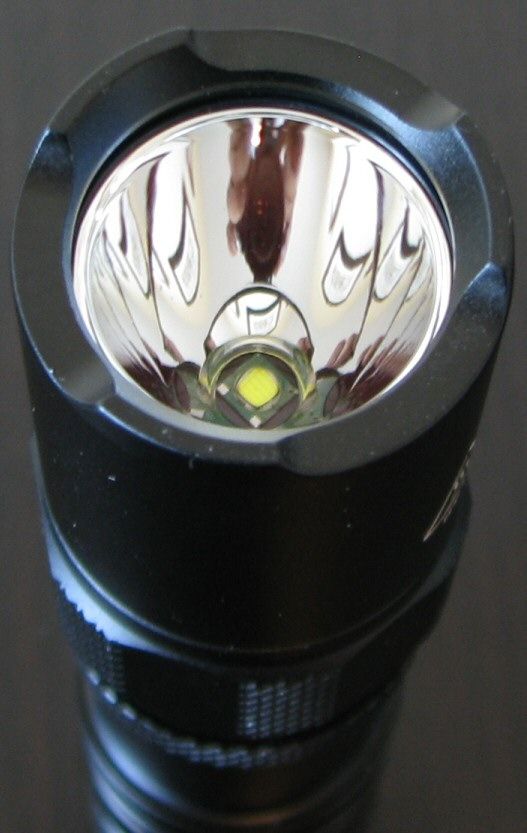
MT25:
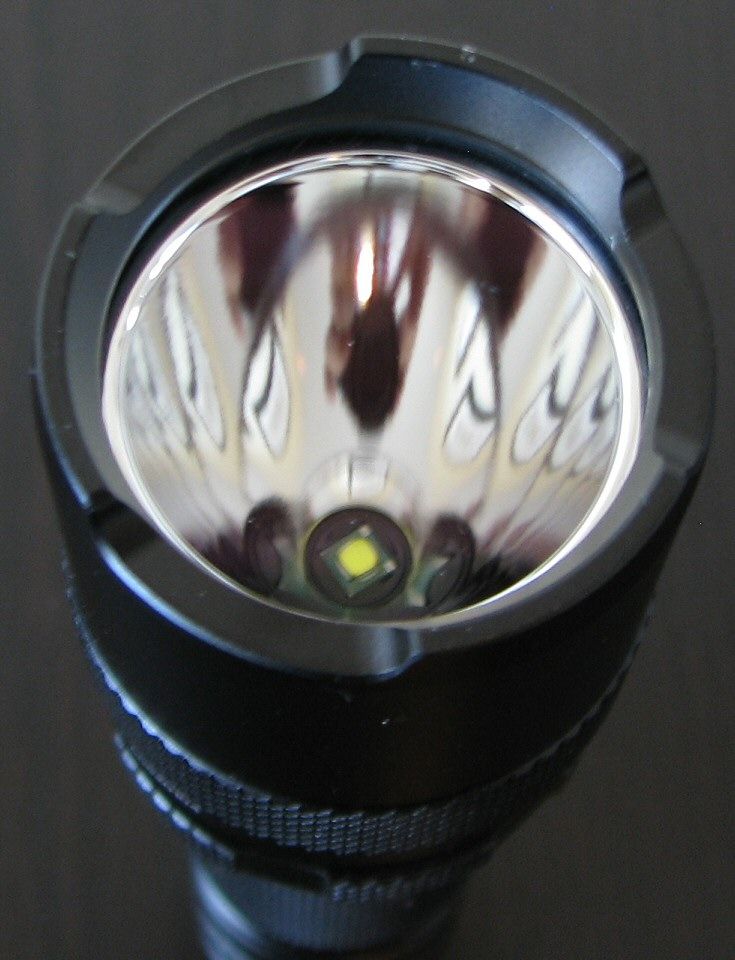
The main difference between the lights is the larger head on the MT25. With this comes a larger and deeper reflector (both smooth finish). Here is a close-up of the MT25:

Note that centering is not necessarily perfect on my MT-series samples, but the MT25 above was pretty good.
User Interface
User interface is similar to the Jetbeam "Performance" series (i.e. PA- or PC- series lights). Turn the light on by pressing the tailcap clicky (press for momentary on, click for locked on).
With the head tight, you get Turbo output. With the head loosened, you get the programmed user-selected state. You select the output mode for this state by soft-pressing the clicky switch from off (or clicking off-on from on). The sequence on is: Hi > Med > Lo > SOS > Strobe, in a repeating loop. The light has mode memory, and saves the last setting used in the head-loosened state. Note that Hi on the user-selected head-loose state is lower than Turbo on the head-tight state (i.e., there are four defined output constant modes).
Note that the MT-series lights do not suffer from the programming glitch noted on the Jetbeam Performance series lights, where rapid flashing of the tailcap in Turbo could alter the saved state of the user-selected mode. The MT-series lights all performed as expected (i.e., memory mode remains constant, no matter what happens in the Turbo mode). :thumbsup:
For more information on the light, including the build and user interface, please see my new video overview:
As always, videos were recorded in 720p, but YouTube typically defaults to 360p. Once the video is running, you can click on the configuration settings icon and select the higher 480p to 720p options. You can also run full-screen.
PWM/Strobe
Nitecore claims that the MT-series lights are current controlled, and I believe that is true. However, there is a re-occurring signal pattern on the Lo/Med/Hi levels (but not Turbo) for all members of this family. Here's a representative sample:
MT2C Hi:
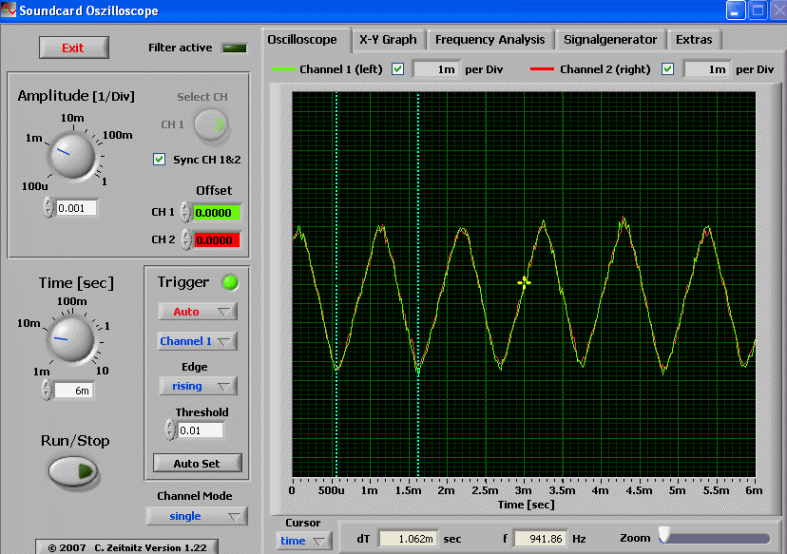
MT25 Hi:
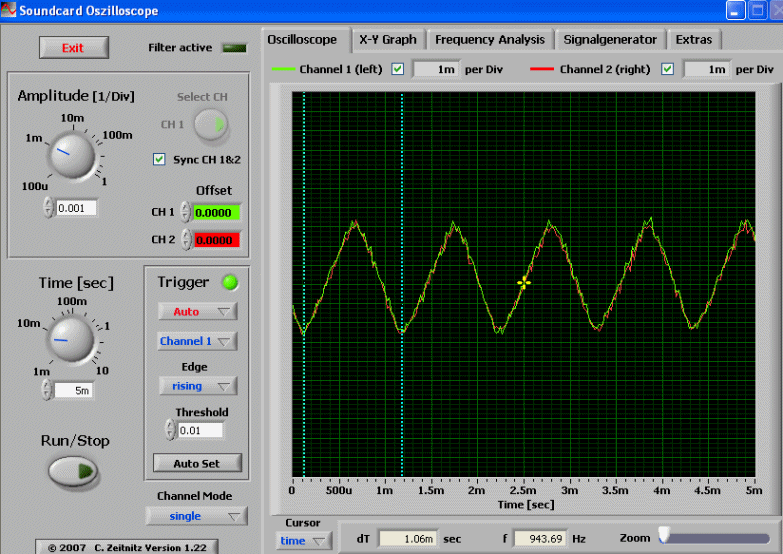
Please note that this "zigzag" pattern is most definitely NOT pulse-width modulation (PWM). I have tested half-a-dozen MT-series lights right now, and my oscilloscope shows this consistent triangular circuit signal at somewhere between ~950-1050 Hz on the Lo/Med/Hi (but not Turbo) of each model.
Rest assured, it is certainly not as visible as 1kHz PWM would be. I've noted in the past that visual flicker detection increases on PWM lights as you go to lower outputs (even when you keep the PWM freq constant). Part of this may simply be due to different flicker detection thresholds at different intensities, but I suspect it is due in part to the pulse-width changes in the PWM wave (i.e., the shorter "on" / longer "off" phase in the PWM signal at low intensities is more noticeable for some reason). In the case here, the zigzag signal is constant at all outputs (i.e., it is pulse-constant), with a consistent slope (i.e., it is waveform-constant). This appears to drastically reduce the "noticeability" of the signal compared to PWM.
Also, I have noted that this signal intensity is quite variable across my MT-series samples (i.e., it is not a full on/off signal, and its amplitude varies considerably). Even with the MT1C on 1xRCR (my most prominent example), the signal is so weak that I cannot see any evidence of it visually on any mode, except when shining on a fan (and even then is fairly mild). It is certainly not visible in actual use (and as everyone here knows, I am particularly sensitive to PWM flicker ).
).
Again, the point here is that the M-series is indeed current-controlled, and you are highly unlikely to be able to detect any sign of this reoccurring circuit signal.
MT2C Strobe:
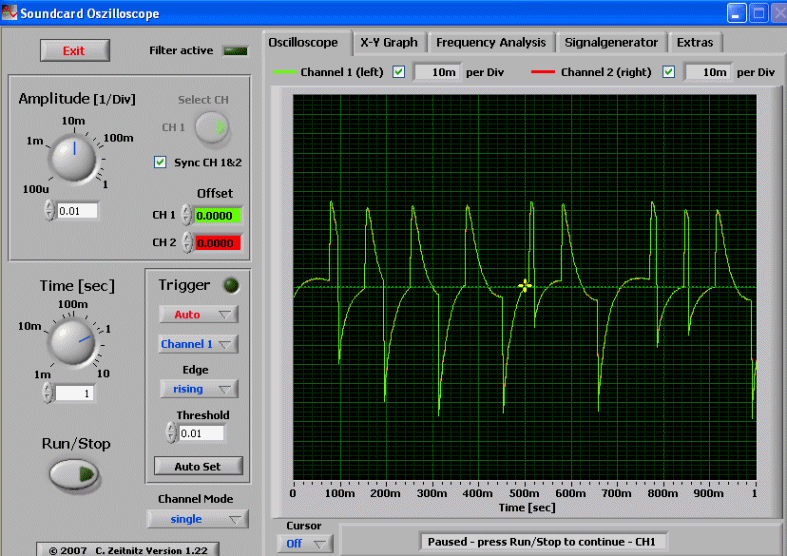
The MT2C and MT25 have the same strobe pattern, where the lights alternate rapidly between two fast frequencies (basically, ~11 Hz and ~16 Hz), in a fairly random way. In other words, there was ~90msec or ~60msec pause between each pulse, but it seemed pretty random which one would occur.
This is different from the other MT-series lights I tested. The MT40 did something similar, except the timing between the two frequencies was consistently alternating (i.e., 90msec, then 60msec, then 90msec, then 60msec, etc.).
The MT1C/MT1A/MT2A were all consistent with each other, but different from the MT40 or MT2C/MT25. In those cases, the three models showed a typical "oscillating" strobe pattern, switching between ~22 Hz and ~12 Hz every 2 secs. Those three lights were also unusual as the individual pulses where longer in duration than typical.
I am not sure why the variation between models, but all are fairly disorienting.
Beamshots:
All lights are on Max output on 1x AW protected 18650 (2200mAh). Lights are about ~0.75 meter from a white wall (with the camera ~1.25 meters back from the wall). Automatic white balance on the camera, to minimize tint differences.

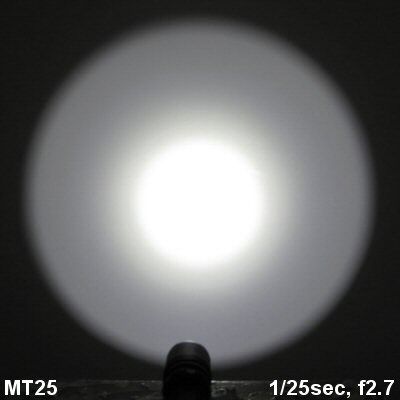
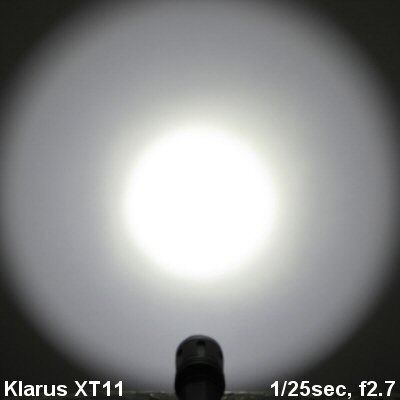
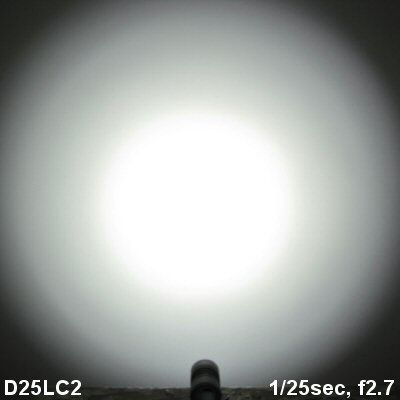
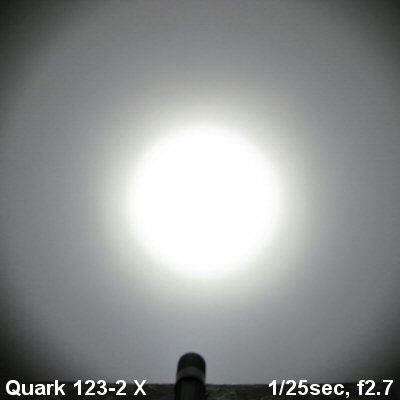
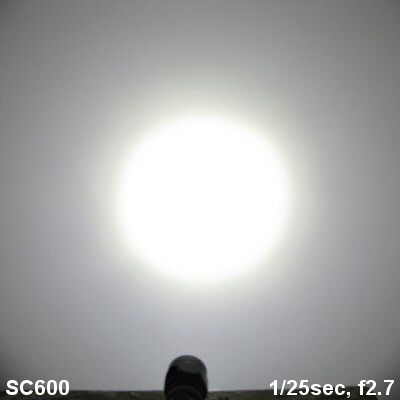
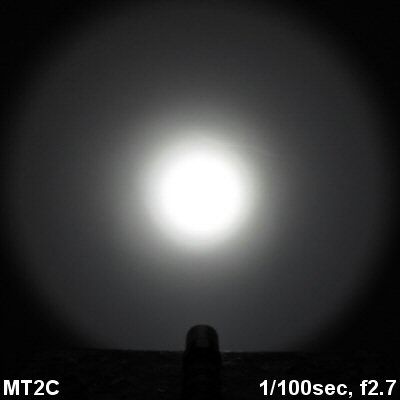
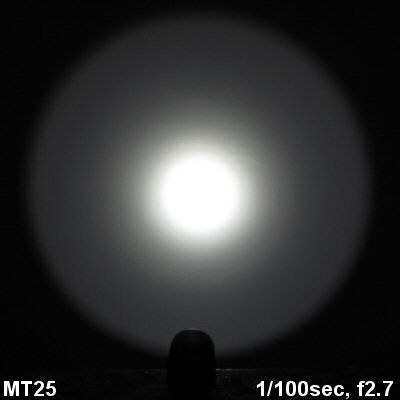
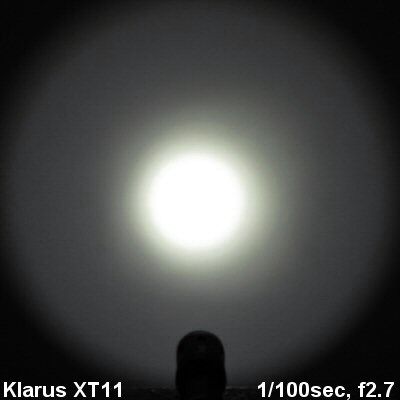
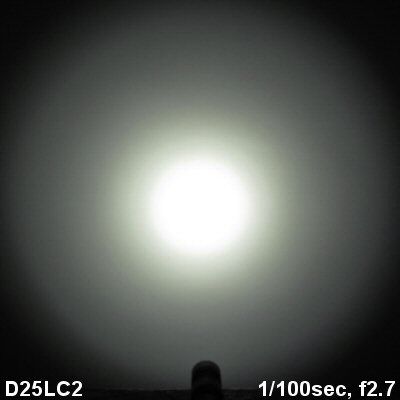
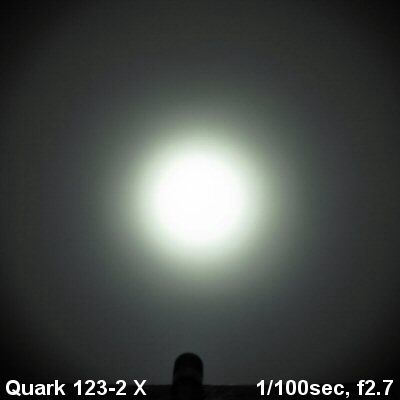


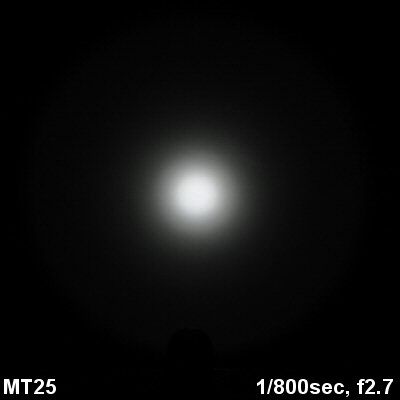
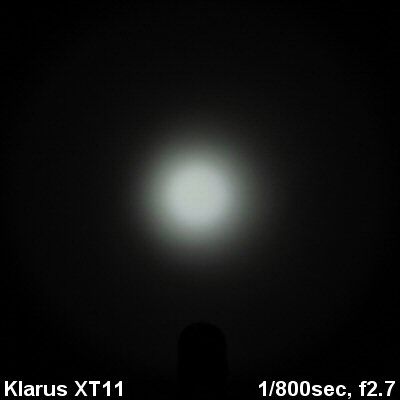
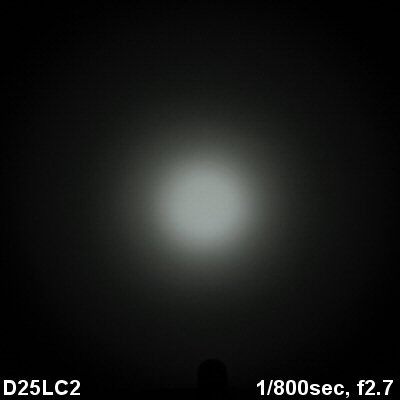
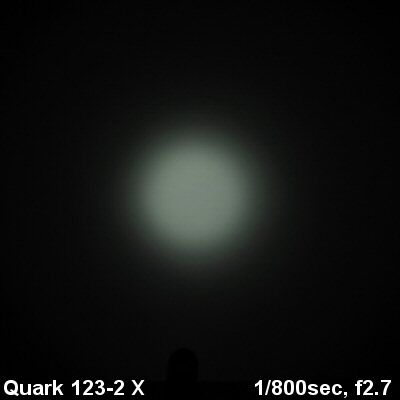
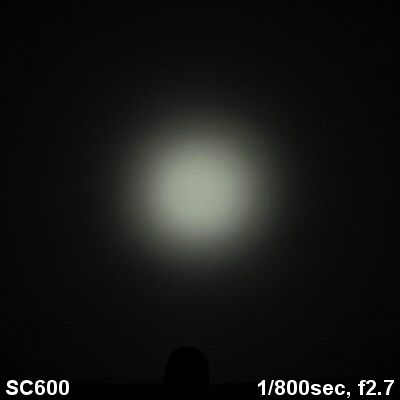
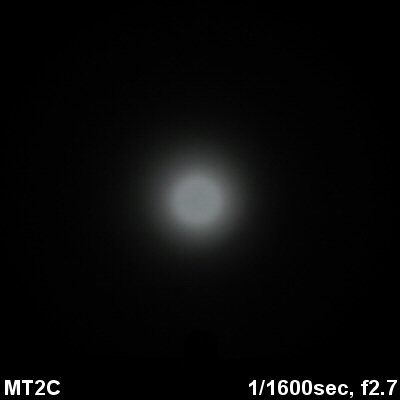
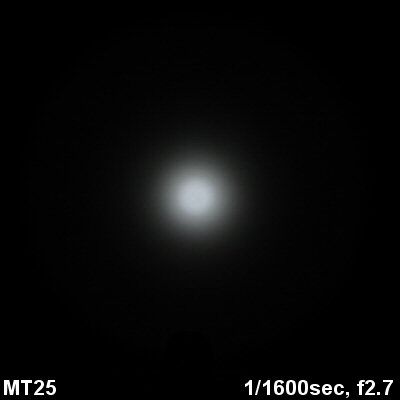
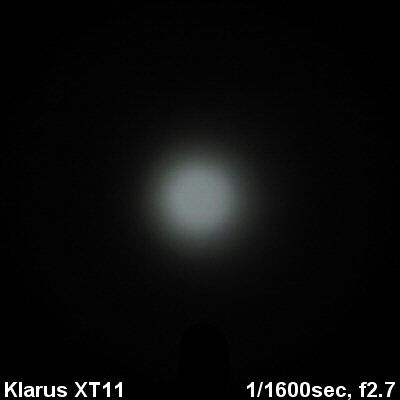
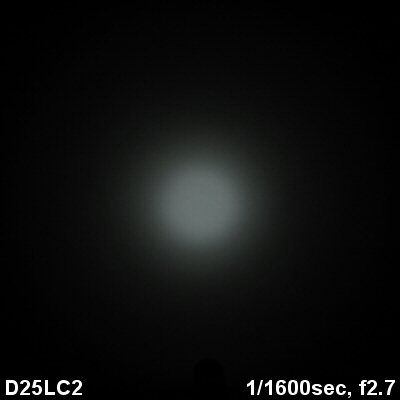
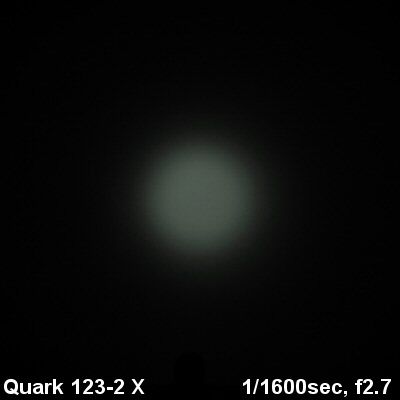
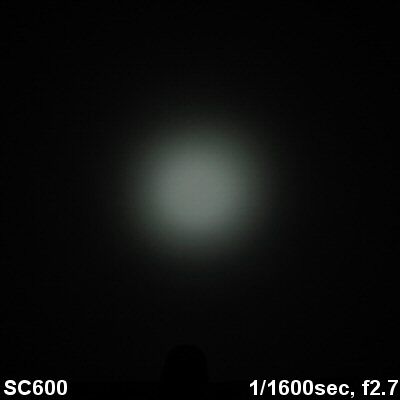
The MT25 is cleary "throwier" than the MT2C, as you would expect.
Testing Method:
All my output numbers are relative for my home-made light box setup, a la Quickbeam's flashlightreviews.com method. You can directly compare all my relative output values from different reviews - i.e. an output value of "10" in one graph is the same as "10" in another. All runtimes are done under a cooling fan, except for any extended run Lo/Min modes (i.e. >12 hours) which are done without cooling.
I have devised a method for converting my lightbox relative output values (ROV) to estimated Lumens. See my How to convert Selfbuilt's Lightbox values to Lumens thread for more info.
Throw/Output Summary Chart:
My summary tables are reported in a manner consistent with the ANSI FL-1 standard for flashlight testing. Please see http://www.flashlightreviews.ca/FL1.htm for a discussion, and a description of all the terms used in these tables.
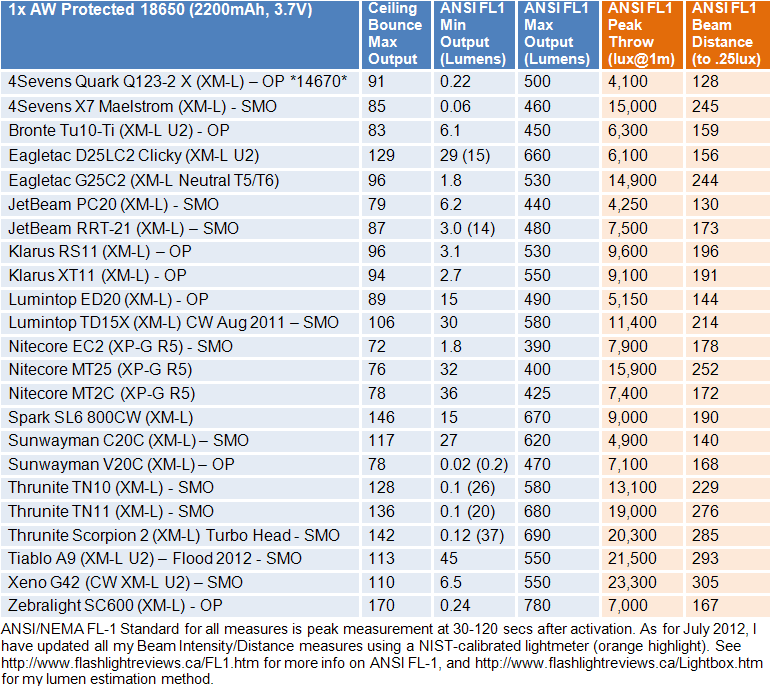
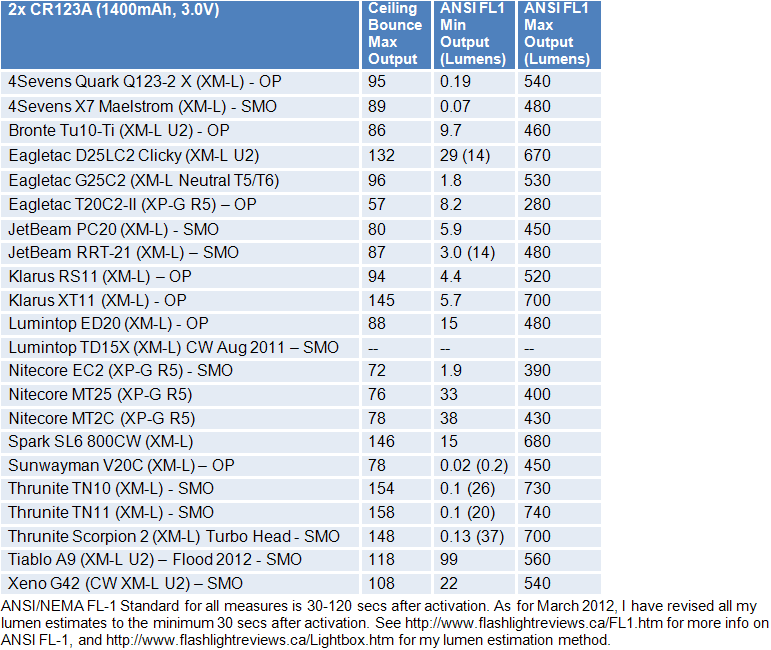

Consistent with my other MT-series reviews, the Nitecore output and throw specs seem reasonably accurate, if a bit conservative.
But as an initial observation, note that my MT2C was actually marginally brighter than the MT25 (the specs have it the other way around). I will discuss output a little further on, after I compare the runtimes (scroll down for my estimated lumen summary tables and discussion at the end of the review).
In terms of throw, the MT25 clearly throws further, thanks to the larger head and reflector.
Output/Runtime Comparison:
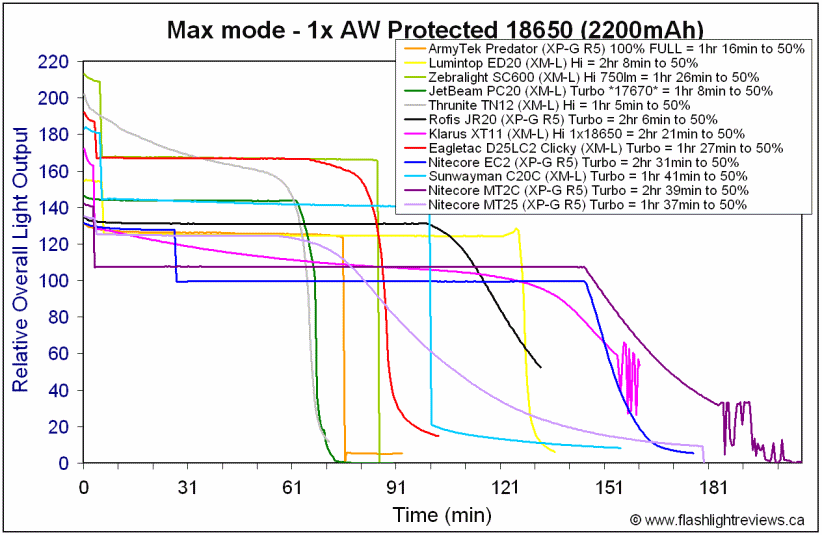
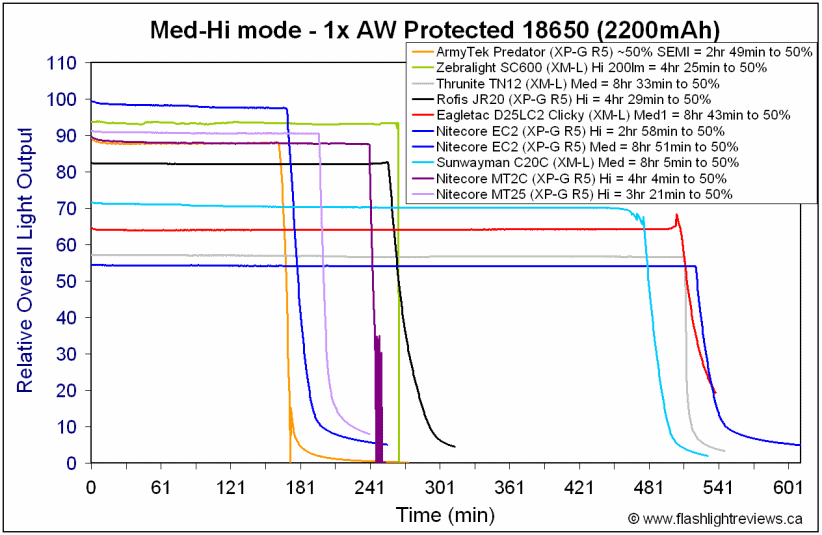
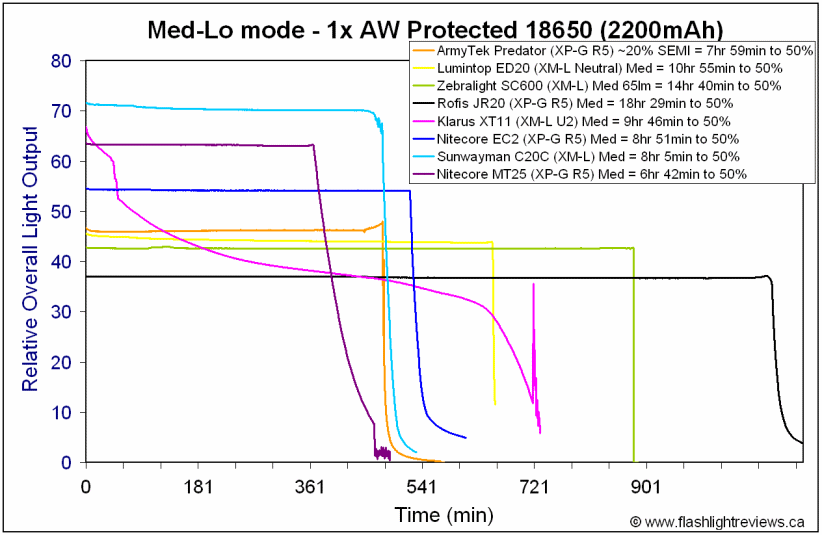



First comment to make is that there is a very distinct difference in the step-down output levels of the MT2C and MT25 on Turbo. Although my MT2C is a bit brighter initially, it drops by approximately one third (~33%) after 3 mins. In contrast, the MT25 only drops by ~10% after 3mins. As a result, the MT25 stays brighter longer – but the MT2C has longer overall runtime. This effect was consistent across all battery types tested.
Otherwise, output/runtime performance is what I would expect for a good current-controlled light, comparing very well to other XP-G R5-equipped lights. Overall runtime specs from Nitecore seem good, considering the higher stated battery capacities used in their testing (and ANSI FL-1 standard of time to 10%).
General Output Comparison:
To better allow you compare output at all levels on all lights, below are detailed tables for each model, on all supported battery types. I have indicated the manufacturer's specs for the identified cell type.
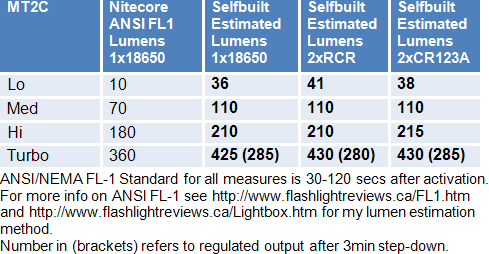
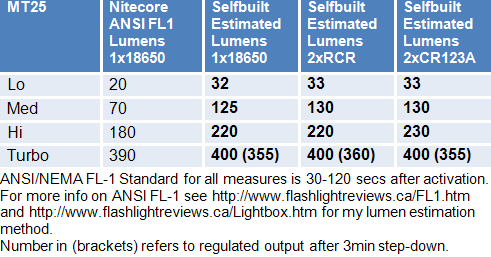
Once again, in general terms, Nitecore seems to be fairly accurate in their reporting of relative output spacing. :thumbsup:
Note however the difference in relative output after step-down occurs on Turbo on the two lights. This is why the MT2C has much longer runtime specs than the MT25, despite having initially similar output. When you take into consideration the lower output of the MT2C after step-down, the extended runtime makes sense (and is consistent with my runtime findings above).
Potential Issues
There is a regular signal at ~1 kHz on all the MT-series lights, but it is not PWM, and it is generally not perceptible. I could see no sign of it visually on my samples, which were flicker-free at all levels. Output/runtime efficiency is very good, in keeping with other current-controlled lights.
Because of the relatively deep and smooth reflectors, you may notice some centre beam artifacts on these lights (i.e., relative dark spot/band in the centre of the hotspot). This is variable on my samples, but is not uncommon on XP-G lights with these types of reflectors.
Although initial output on Turbo is comparable between the lights, the MT2C steps down by ~33% after 3mins for extended runtime, while the MT25 only steps down by ~10%.
Preliminary Observations
As mentioned in my earlier reviews, the new Nitecore "Multitask" MT-series lights remind me a lot of the JetBeam "Backup" and "Performance" series lights (specifically, the appearance of the Jetbeam BA/BC-series lights, and the functionality of the PA/PC-series).
Build-wise, the MT-series is closer to the Jetbeam Backup series, but with upgrades - most obvious is the generous supply of knurling now. The MT-series still has traditional triangular cut screw threads, but feel is good. The switch has a better feel than the previous Jetbeam lights (which were a bit squishy), and you have easier access to the button now.
The main difference between the MT2C and MT25 (both 2xCR123A/RCR, 1x18650 lights) is the size of the head/reflector – with the larger MT25 having greater throw than the more narrowly cylindrical MT2C. Note the beam pattern is fairly throwy for all the MT-series lights, due to the relatively deep and smooth reflectors (which can lead to some artfiacts). But the MT25 definitely stands out as the "throwier" version in this battery class.
There is also a more subtle circuit difference in terms of max output regulation and runtime between the lights. After 3 mins continuous runtime, both lights step-down – but the MT2C steps down further than MT25, providing extended runtime for the MT2C. Otherwise, the two lights are very similar in their relative output level spacings and efficiency/performance (which is consistent with a good current-control circuit).
The interface of all the Multitask-series is very similar to the Jetbeam Performance series lights. With the head loosened, you similarly have access to five modes (Hi > Med > Lo > SOS > Strobe), with mode memory. While more sophisticated than the Backup series, I am never a fan of blinky modes on the same sequence as constant output modes. :shrug: At least they corrected the Jetbeam Performance series programming glitch that allowed the mode memory to change under certain conditions.
The MT2C and MT25 are pretty equivalent performers – it really comes down to what sort of beam pattern you are looking for. As I've said before, the MT-series is a definite step-up from the earlier Jetbeam Backup series (but with comparable price), with a lot of similarities to the Performance series. Please see my MT1C/MT1A/MT2A and MT40 reviews for more for info on those models. :wave:
----
MT2C, MT25 provided by Nitecore for review.


This is my third (and final) review of the "Multi-Task" MT-series lights from Nitecore. In this review, I am comparing the performance of two of the 2xCR123A/RCR, 1x18650 models – the MT2C and MT25. Please see my recent MT1C/MT1A/MT2A and M40 reviews for more details on those models.
Manufacturer Reported Specifications:
Note: as always, these are only what the manufacturer reports. To see my actual testing results, scroll down the review.
Common Specs:
- LED: CREE XP-G R5
- Two rapid switching modes suit various user requirements
- High efficiency current circuit board regulates output
- User-defined mode allows for customized brightness
- Anti-rolling design
- Reverse polarity protection
- Toughened ultra-clear mineral glass lens with anti-reflective coating
- HA III Military grade hard anodized aluminum alloy body wih anti-rolling design
- Purpose-made knurling for better grip
- Water-resistant to IPX-8 standards
- Impact resistant to 4.9 ft. (1.5 m)
- Accessories: lanyard, spare O-ring
- Output/Runtime: Turbo: 360 lumens (3 hours, 45 min), High: 180 lumens (5 hours), Mid: 70 lumens (15 hours), Low: 10 lumens (75 hours)
- Peak beam distance: 155 m
- Peak beam intensity: 6,000 cd
- Use 1x18650 (Recommended), 2xCR123A (Recommended), or 2xRCR
- Length x Head Diameter x Tail Diameter: 4.92" x 1" x 1" (125 mm x 25.4 mm x 25.4 mm)
- Weight: 2.6 oz. (76 g)
- MSRP: ~$48
- Output and runtime: Turbo: 390 lumens (2 hours), High: 180 lumens (5 hours), Mid: 70 lumens (15 hours), Low: 20 lumens (45 hours)
- Peak beam distance: 228 m
- Peak beam intensity: 13,000 cd
- Use 1x18650 (Recommended), 2xCR123A (Recommended), or 2xRCR
- Length x Head Diameter x Tail Diameter: 5.59" x 1.33" x 1" (142 mm x 34 mm x 25.4 mm)
- Weight: 4.39 oz. (124.5 g) Batteries not included
- Additional accessory: holster
- MSRP: ~$54

All the MT-series lights come in basic display packaging, similar to the recent Nitecore Explorer and SENS series (MT1A shown above as an example). Extras are generally comparable, and include a basic wrist lanyard, extra o-rings and boot cover, removable pocket clip, manual and warranty card. The MT25 also comes with a basic holster with velcroed closing flap (not shown).
Here's a quick overview of the family:


From left to right: Duracell CR123A, AA (NiMH); Nitecore MT1C, MT1A, MT2A, MT2C, MT25, M40, AW Protected 18650 (2200mAh).
And now a comparison on the MT2C and MT25:



From left to right: CR123A; AW Protected 18650; Nitecore MT2C, MT25; Lumintop PS20, ED20; Nitecore EC2; Quark Q123-2; Nitecore IFE2; Jetbeam RRT-21.
All dimensions are given with no batteries installed:
Nitecore MT2C: Weight: 75.9g, Length: 125.3mm, Width (bezel): 25.5mm
Nitecore MT25: Weight 124.6g, Length: 142.9mm, Width (bezel): 34.2mm
Eagletac D25LC2: Weight: 50.0g, Length: 116.3mm, Width (bezel): 22.5mm
Foursevens Quark Q123-2-X (Regular tailcap): Weight: 44.6g, Length: 112.7mm, Width (bezel) 22.0mm
Klarus XT11: Weight 133.0g, Length: 148.8, Width (bezel) 35.0mm
Sunwayman V20C: Weight: 117.4g, Length 133.0mm, Width (bezel) 32.2mm
Thrunite TN10: Weight: 154.7g, Length: 145.5mm, Width (bezel): 35.1mm
Zebralight SC600: Weight 87.2g, Length: 107.8mm, Width (bezel) 29.7mm
MT1C:

MT25:

MT1C:

MT2C/MT25:

Anodizing is a matte black, with no chips on my samples. Labels are bright white, clearly legible against the dark background. Both models have actual knurling across the tailcap and portions of the battery tube and head (the MT25 has considerably more than the MT2C). Knurling is actually of reasonable aggressiveness, and grip is improved compared to the Jetbeam Backup-series lights which these new Nitecores most closely resemble (i.e., BC- and BA-series lights).
On the MT2C, there is a reverse-polarity setup in the head, so flat-top cells will not work in these lights (i.e., need a small button top, the same as the MT1C/MT1A/MT2A). The MT25, however, has a spring on the contact board in the head, so flat top cells can be used. Both lights have body tubes wide enough to take high-capacity protected 18650 cells. :thumbsup:
Both lights come with the same removable pocket clip, which is of the standard clip-on variety (i.e., similar to the Jetbeam Performance and Backup series lights).
Screw threads are standard triangular cut, and seem of good quality. They are also anodized for lock-out at the tailcap. Tailcaps size and threading are identical across the two models (i.e., are interchangeable). Tail switch is a forward clicky, with traditional feel. The Jetbeam Backup and Performance series lights often felt a bit "squishy" in comparison.

Light can tailstand, but may be a bit wobbly (due to the partial raised areas for the lanyard attachment on the tailcap).
MT2C:

MT25:

The main difference between the lights is the larger head on the MT25. With this comes a larger and deeper reflector (both smooth finish). Here is a close-up of the MT25:

Note that centering is not necessarily perfect on my MT-series samples, but the MT25 above was pretty good.
User Interface
User interface is similar to the Jetbeam "Performance" series (i.e. PA- or PC- series lights). Turn the light on by pressing the tailcap clicky (press for momentary on, click for locked on).
With the head tight, you get Turbo output. With the head loosened, you get the programmed user-selected state. You select the output mode for this state by soft-pressing the clicky switch from off (or clicking off-on from on). The sequence on is: Hi > Med > Lo > SOS > Strobe, in a repeating loop. The light has mode memory, and saves the last setting used in the head-loosened state. Note that Hi on the user-selected head-loose state is lower than Turbo on the head-tight state (i.e., there are four defined output constant modes).
Note that the MT-series lights do not suffer from the programming glitch noted on the Jetbeam Performance series lights, where rapid flashing of the tailcap in Turbo could alter the saved state of the user-selected mode. The MT-series lights all performed as expected (i.e., memory mode remains constant, no matter what happens in the Turbo mode). :thumbsup:
For more information on the light, including the build and user interface, please see my new video overview:
As always, videos were recorded in 720p, but YouTube typically defaults to 360p. Once the video is running, you can click on the configuration settings icon and select the higher 480p to 720p options. You can also run full-screen.
PWM/Strobe
Nitecore claims that the MT-series lights are current controlled, and I believe that is true. However, there is a re-occurring signal pattern on the Lo/Med/Hi levels (but not Turbo) for all members of this family. Here's a representative sample:
MT2C Hi:

MT25 Hi:

Please note that this "zigzag" pattern is most definitely NOT pulse-width modulation (PWM). I have tested half-a-dozen MT-series lights right now, and my oscilloscope shows this consistent triangular circuit signal at somewhere between ~950-1050 Hz on the Lo/Med/Hi (but not Turbo) of each model.
Rest assured, it is certainly not as visible as 1kHz PWM would be. I've noted in the past that visual flicker detection increases on PWM lights as you go to lower outputs (even when you keep the PWM freq constant). Part of this may simply be due to different flicker detection thresholds at different intensities, but I suspect it is due in part to the pulse-width changes in the PWM wave (i.e., the shorter "on" / longer "off" phase in the PWM signal at low intensities is more noticeable for some reason). In the case here, the zigzag signal is constant at all outputs (i.e., it is pulse-constant), with a consistent slope (i.e., it is waveform-constant). This appears to drastically reduce the "noticeability" of the signal compared to PWM.
Also, I have noted that this signal intensity is quite variable across my MT-series samples (i.e., it is not a full on/off signal, and its amplitude varies considerably). Even with the MT1C on 1xRCR (my most prominent example), the signal is so weak that I cannot see any evidence of it visually on any mode, except when shining on a fan (and even then is fairly mild). It is certainly not visible in actual use (and as everyone here knows, I am particularly sensitive to PWM flicker
Again, the point here is that the M-series is indeed current-controlled, and you are highly unlikely to be able to detect any sign of this reoccurring circuit signal.
MT2C Strobe:

The MT2C and MT25 have the same strobe pattern, where the lights alternate rapidly between two fast frequencies (basically, ~11 Hz and ~16 Hz), in a fairly random way. In other words, there was ~90msec or ~60msec pause between each pulse, but it seemed pretty random which one would occur.
This is different from the other MT-series lights I tested. The MT40 did something similar, except the timing between the two frequencies was consistently alternating (i.e., 90msec, then 60msec, then 90msec, then 60msec, etc.).
The MT1C/MT1A/MT2A were all consistent with each other, but different from the MT40 or MT2C/MT25. In those cases, the three models showed a typical "oscillating" strobe pattern, switching between ~22 Hz and ~12 Hz every 2 secs. Those three lights were also unusual as the individual pulses where longer in duration than typical.
I am not sure why the variation between models, but all are fairly disorienting.
Beamshots:
All lights are on Max output on 1x AW protected 18650 (2200mAh). Lights are about ~0.75 meter from a white wall (with the camera ~1.25 meters back from the wall). Automatic white balance on the camera, to minimize tint differences.
























The MT25 is cleary "throwier" than the MT2C, as you would expect.
Testing Method:
All my output numbers are relative for my home-made light box setup, a la Quickbeam's flashlightreviews.com method. You can directly compare all my relative output values from different reviews - i.e. an output value of "10" in one graph is the same as "10" in another. All runtimes are done under a cooling fan, except for any extended run Lo/Min modes (i.e. >12 hours) which are done without cooling.
I have devised a method for converting my lightbox relative output values (ROV) to estimated Lumens. See my How to convert Selfbuilt's Lightbox values to Lumens thread for more info.
Throw/Output Summary Chart:
My summary tables are reported in a manner consistent with the ANSI FL-1 standard for flashlight testing. Please see http://www.flashlightreviews.ca/FL1.htm for a discussion, and a description of all the terms used in these tables.



Consistent with my other MT-series reviews, the Nitecore output and throw specs seem reasonably accurate, if a bit conservative.
But as an initial observation, note that my MT2C was actually marginally brighter than the MT25 (the specs have it the other way around). I will discuss output a little further on, after I compare the runtimes (scroll down for my estimated lumen summary tables and discussion at the end of the review).
In terms of throw, the MT25 clearly throws further, thanks to the larger head and reflector.
Output/Runtime Comparison:






First comment to make is that there is a very distinct difference in the step-down output levels of the MT2C and MT25 on Turbo. Although my MT2C is a bit brighter initially, it drops by approximately one third (~33%) after 3 mins. In contrast, the MT25 only drops by ~10% after 3mins. As a result, the MT25 stays brighter longer – but the MT2C has longer overall runtime. This effect was consistent across all battery types tested.
Otherwise, output/runtime performance is what I would expect for a good current-controlled light, comparing very well to other XP-G R5-equipped lights. Overall runtime specs from Nitecore seem good, considering the higher stated battery capacities used in their testing (and ANSI FL-1 standard of time to 10%).
General Output Comparison:
To better allow you compare output at all levels on all lights, below are detailed tables for each model, on all supported battery types. I have indicated the manufacturer's specs for the identified cell type.


Once again, in general terms, Nitecore seems to be fairly accurate in their reporting of relative output spacing. :thumbsup:
Note however the difference in relative output after step-down occurs on Turbo on the two lights. This is why the MT2C has much longer runtime specs than the MT25, despite having initially similar output. When you take into consideration the lower output of the MT2C after step-down, the extended runtime makes sense (and is consistent with my runtime findings above).
Potential Issues
There is a regular signal at ~1 kHz on all the MT-series lights, but it is not PWM, and it is generally not perceptible. I could see no sign of it visually on my samples, which were flicker-free at all levels. Output/runtime efficiency is very good, in keeping with other current-controlled lights.
Because of the relatively deep and smooth reflectors, you may notice some centre beam artifacts on these lights (i.e., relative dark spot/band in the centre of the hotspot). This is variable on my samples, but is not uncommon on XP-G lights with these types of reflectors.
Although initial output on Turbo is comparable between the lights, the MT2C steps down by ~33% after 3mins for extended runtime, while the MT25 only steps down by ~10%.
Preliminary Observations
As mentioned in my earlier reviews, the new Nitecore "Multitask" MT-series lights remind me a lot of the JetBeam "Backup" and "Performance" series lights (specifically, the appearance of the Jetbeam BA/BC-series lights, and the functionality of the PA/PC-series).
Build-wise, the MT-series is closer to the Jetbeam Backup series, but with upgrades - most obvious is the generous supply of knurling now. The MT-series still has traditional triangular cut screw threads, but feel is good. The switch has a better feel than the previous Jetbeam lights (which were a bit squishy), and you have easier access to the button now.
The main difference between the MT2C and MT25 (both 2xCR123A/RCR, 1x18650 lights) is the size of the head/reflector – with the larger MT25 having greater throw than the more narrowly cylindrical MT2C. Note the beam pattern is fairly throwy for all the MT-series lights, due to the relatively deep and smooth reflectors (which can lead to some artfiacts). But the MT25 definitely stands out as the "throwier" version in this battery class.
There is also a more subtle circuit difference in terms of max output regulation and runtime between the lights. After 3 mins continuous runtime, both lights step-down – but the MT2C steps down further than MT25, providing extended runtime for the MT2C. Otherwise, the two lights are very similar in their relative output level spacings and efficiency/performance (which is consistent with a good current-control circuit).
The interface of all the Multitask-series is very similar to the Jetbeam Performance series lights. With the head loosened, you similarly have access to five modes (Hi > Med > Lo > SOS > Strobe), with mode memory. While more sophisticated than the Backup series, I am never a fan of blinky modes on the same sequence as constant output modes. :shrug: At least they corrected the Jetbeam Performance series programming glitch that allowed the mode memory to change under certain conditions.
The MT2C and MT25 are pretty equivalent performers – it really comes down to what sort of beam pattern you are looking for. As I've said before, the MT-series is a definite step-up from the earlier Jetbeam Backup series (but with comparable price), with a lot of similarities to the Performance series. Please see my MT1C/MT1A/MT2A and MT40 reviews for more for info on those models. :wave:
----
MT2C, MT25 provided by Nitecore for review.

